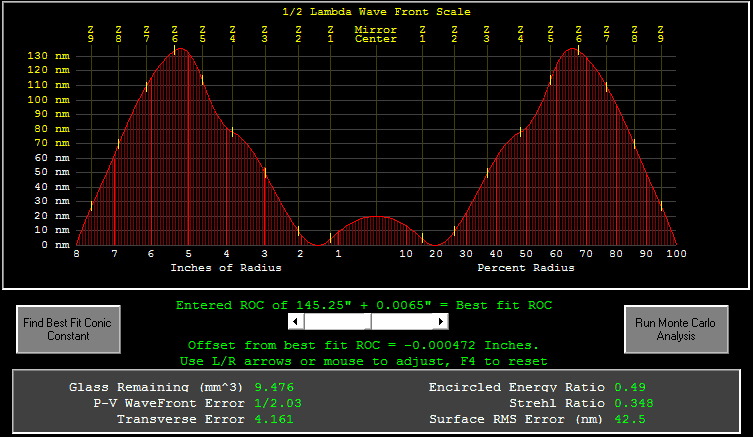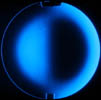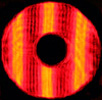June 26,
2012: Not up to my standards - 16", Part 2
This
16" mirror was refigured back in February, and its owner has finally
had a chance to really see what it can do on a night of good seeing.
The plot below shows the surface error before I refigured the
mirror. Photos of the surface roughness are included in Part 1.

So, here is the story, as told by the client in his post on my Yahoo group.
"HI, I recently had my 16" f/4.5 mirror refigured by Mike and wanted to share with
you guys my experience with it so far. The mirror and scope were bought
secondhand about 3 years ago. It came with a complete testing report from a
reputable mirror maker and was reported as being 0.952 Strehl, 1/11 wave P-V.
First warning sign came when I noticed the star test didn't seem very good. It
seemed to be very undercorrected but since this scope was meant to be used for
deep sky objects (which is my main area of interest), I didn't make a big deal
of it since any problems with the mirror would be very subtle and besides
galaxies seemed ok and globulars were tremendous. This plus the fact that I
live in the Northeast US, which isn't particularly known for its great observing
conditions, led me to believe that any lack of contrast or resolution was due to
atmospheric conditions, not the scope.
However even on the best of nights, viewing Jupiter and Saturn was very
frustrating. Image breakdown of both would always occur very quickly with the
scope even with "manageable" magnifications (150x-200x on steady nights). I also
had noticed that there was no real "snap" to focus with the scope - images were
always very drawn out. I had always considered having the mirror retested as a
precautionary measure just to see what results would come out to and after
enough time with the scope, I followed through.
Mike tested the mirror and the results he found were pretty contrary to what
that the test reports stated. Using the Foucault readings the mirror tested at
0.35 Strehl and ½ wave P-V. The surface of the mirror was also found to be
extremely rough. Thus this is one of those examples that shows you should never
ever take those sheets as fact, even if it is from someone reputable.
After Mike refigured the mirror I had a chance to use the scope a few days
later. It was actually fairly windy so seeing wasn't too great but I definitely
noticed a difference when looking at galaxies – particularly M81/M82 and the
Whirlpool. The spiral shape of the whirlpool galaxy was easily visible just as
before but the view was a lot crisper –kind of like a few sheets of veil were
lifted from the Whirlpool image so that one could see deeper – at a different
level. In addition the companion galaxy was more pronounced (mind you these are
just crude observations, the first time with the mirror I was really just trying
to imagine what I had seen with the mirror before I sent it into Mike and how
noticeable of a difference there was). The view of M82 was much more significant
– the mottled appearance and dust lane was very obvious during this session –
previously this galaxy still appeared mottled but it was much more subtle
–averted vision was needed to really see the contrast between the dust lane and
the rest of the galaxy.
About a week ago I was observing Saturn and went up the magnification
progression from 107x to 201x to 241x to 362x. Cassini Division was obvious at
this point and so were the southern temperate belts though no contrast
difference was observable to separate them. By the time I hit over the 300x
mark I figured I probably wasn't going to take it up much further – that was
with a 5mm Takahashi LE. So went up a little bit more to a 9mm TV Nagler T6
barlowed with a 2x AP Barcon, image still held at 402x. At this point I could
definitely make out the C ring but only on the sides as it was definitely not as
dark as the background sky. Then barlowed the 7.5mm Tak LE – image still held at
476x. All the while I was thinking to myself "This is probably the most it will
take" and "it cant possibly go any higher" but it did and I topped out at 724x
with still no image breakdown! Actually even though there wasn't much more
resolution after about 400x the Cassini division was razor sharp. The only
reason I stopped was because I ran out of eyepieces and couldn't go any further
(I did pull the eyepiece out of the barlow to its max distance so I would say it
topped off at around 750x, I wasn't going to measure).
Obviously a lot has to do with the seeing conditions but there was always the
occasional night of good to excellent seeing with the mirror before Mike
refigured it but in no way did I ever get higher than 400x without the image
completely breaking down. Mike did a spectacular job refiguring my mirror and it
also showed me that a good figured mirror doesn't always show itself with the
immediate eyepopping view – it can also be how it handles those uber-high
magnifications. Thanks again Mike!"
You're
very welcome, and I hope you get to observe on many more steady nights
like that one. May I recommend the Winter Star Party?
The
moral of the story is that if you have a telescope that produces poor
images under all conditions, then you may have a problem with the
optics. If you want that to change, at some point you have to
stop making excuses for the mirrors and get them tested and fixed.
Please check back for future installements of "In
the Shop".
Mike
Lockwood
Lockwood Custom Optics




